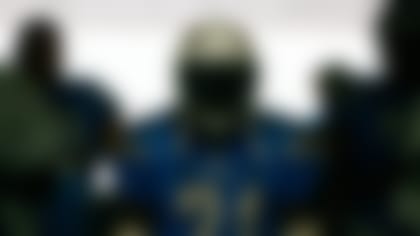They were that close. Believe it.
"A Football Life: LaDainian Tomlinson" is an awesome doc, a typical rendering of everything that makes NFL Films, well, NFL Films. It gave us all unique insight into the football (and ancestral) synchronicity that made LaDainian Tomlinson a special player. But if one part of his story merits further mention, it's that 2006 San Diego Chargers team, perhaps the most loaded in Bolts history.
You know the one. That group of guys hoisting LT2 -- Lawrence Taylor will always be the first LT -- in the corner of the end zone after the lightning-quick tailback broke the single-season rushing touchdown record. That coaching staff that had not just Marty Schottenheimer perched on top, but some pretty special lieutenants in offensive coordinator Cam Cameron (whose work landed him a head coaching gig) and defensive coordinator Wade Phillips. And that roster filled with Pro Bowl talent in Antonio Gates, Marcus McNeill, Jamal Williams, Shawne Merriman, Shaun Phillips and guys like Michael Turner on the bench. That's merely scratching the surface.
On the surface, this was a 14-2 football team. But there was so much more to it. Starting with the fact that the Chargers had the Indianapolis Colts' number -- Indy eventually won it all in 2006 -- and matched up with them very well. In fact, Schottenheimer's club marched into Indy in 2005 and handed the 13-0 Colts a big fat L, thus ending any hopes of an undefeated season while allowing Don Shula and the '72 Miami Dolphins to toast each other again.
"We beat the Colts, like, every year," Merriman said. "We were a Super Bowl team."
A Producer's Diary

The Man behind the visor. Check out the story behind "A Football Life: LaDainian Tomlinson" More...
Speaking of, the Colts' opponents in the Super Bowl that season, meanwhile, were the Chicago Bears, a defensive playmaking team like the Chargers who had Rex Grossman at quarterback and Thomas Jones at running back. Not exactly Philip Rivers and Tomlinson, the 2006 NFL MVP.
Forget the Colts, or the Bears, for that matter. It's a wonder that the Chargers didn't dominate the AFC in the mid-2000s. Rivers was in his third year in 2006, though he was really a rookie, considering how little he played in his first two seasons. Vincent Jackson also was a pup, a couple of years from busting out as a No. 1 receiver in 2009. Gates? A fourth-year pro who already was redefining the tight end position, big play after big play.
Gates' game-changing ability was matched, if not exceeded, by a pass rush that could get after it. Merriman and Phillips came off the edge in the Chargers' 3-4 to rack up 28.5 sacks between them. At inside linebacker, Donnie Edwards could more than keep up with running backs in coverage. And Williams was as dominant at the nose as anyone in football.
So what happened? Why did this Chargers team never win it all?
"A Football Life" couldn't dig quite that deeply in 60 minutes, but many people point to the odd dismissal of the head coach following the 2006 season. Tomlinson referred to it as "breaking up the team," and based on the results, he has a point.
Norv Turner would take over for the departed Schottenheimer, but only after general manager A.J. Smith's late decision -- some say fueled by his me vs. you mentality -- caused the club to miss out on other available options, such as Ken Whisenhunt, who led a less talented Arizona Cardinals club to the Super Bowl less than two years later. While Turner's Chargers went to the AFC Championship Game in 2007 and the playoffs in 2008, the team never was quite as good all around as the 14-2 club from 2006. Nor did it approach that regular-season win total.
There were, of course, other factors. Merriman's knee gave out in 2008; shortly thereafter, his game did likewise, for which he cited Phillips' departure. "Wade Phillips leaving meant more to my career than injuries or anything," says Merriman. With the Chargers personnel perfectly suited for Phillips' pressure-based 3-4, having him take the Cowboys' head coaching job would become one of the cracks in the dam.
Injuries always are. McNeill would have his own troubles, while Tomlinson dealt with both a bad knee and a diminished role in 2007. In fact, it was ironic that the club went further in '07 despite not being as good, as they had to beat the Colts to get to the AFC Championship Game. And the team that eventually took them out -- the New England Patriots -- had also ended the Chargers' magical run in '06.
Perhaps that's the true rub. Rather than remember the '06 Chargers as a great team derailed by a GM's ego, coaching changes, injuries or whatever else, perhaps it's best to just say they were held back by the likeliest factor: football. It doesn't sound sexy. It's merely truth.
The Patriots beat Schottenheimer's last NFL team the old-fashioned way: by outcoaching him and making the big play when it mattered. That's how a lot of the big guns in NFL history go down (see: the 1987 San Francisco 49ers and the 2007 Dallas Cowboys for more).
With an 11-point first-half lead, the Chargers got away from LT and the run game. Big mistake. That was the club's bread-and-butter, and it would have served to burn clock.
Then there was Troy Brown, a never-say-die player -- who had been cut three times by former Patriots coach Bill Parcells -- making a never-say-die play. With the Chargers clinging to an 8-point lead in the fourth quarter, safety Marlon McCree seemingly sealed the deal with an interception off Tom Brady. That's when Brown completed the heads-up play of the decade, violently stripping the ball from McCree's grasp as if that was how New England's play had been drawn up. San Diego would have had the ball, with the best player in pro football ready to burn the clock and 6:25 minutes to play.
Except not.
Pats' ball, courtesy of Brown. Pats go on to score, courtesy of Brady. The rest? Chargers lore. Just not the good kind.
"A Football Life: LaDainian Tomlinson" premieres Tuesday, September 3rd at 9PM on NFL Network.



